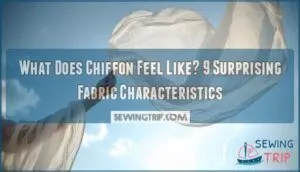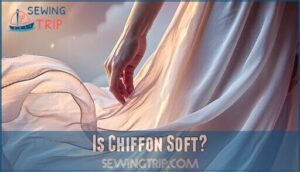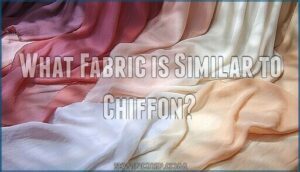This site is supported by our readers. We may earn a commission, at no cost to you, if you purchase through links.
 When you touch chiffon, it feels like holding a cloud. This fabric is incredibly lightweight and smooth, almost like silk against your skin.
When you touch chiffon, it feels like holding a cloud. This fabric is incredibly lightweight and smooth, almost like silk against your skin.
You’ll notice it’s slightly crisp but never rough or scratchy. Chiffon has a flowing, weightless quality that makes it seem to float in your hands.
It’s delicate and transparent, giving it an ethereal feel that’s both luxurious and fragile. The texture varies slightly depending on whether it’s made from silk or synthetic materials, but it always maintains that signature gossamer-like touch.
Understanding chiffon’s unique characteristics can help you care for and style this beautiful fabric properly.
Table Of Contents
Key Takeaways
- You’ll feel chiffon’s cloud-like texture that’s incredibly lightweight and smooth, with a flowing quality that seems to float in your hands while maintaining a slightly crisp but never scratchy feel.
- You won’t find chiffon itchy if it’s made from silk, but synthetic versions like polyester can cause skin irritation due to their rougher weave and electrostatic properties.
- You can’t wear chiffon alone since it’s remarkably see-through due to its open weave construction – you’ll need proper layering with nude slips or camisoles for appropriate coverage.
- You’ll discover chiffon’s durability surprises many people, especially synthetic versions that resist damage better than silk, though it requires gentle handling and proper care to maintain its ethereal beauty.
What Does Chiffon Feel Like?
When you first touch chiffon, you’ll notice its distinctive texture that sets it apart from other fabrics.
Chiffon whispers against your fingertips like captured moonlight, promising elegance with every delicate touch.
The chiffon fabric texture feels surprisingly complex – it’s simultaneously soft to touch yet has a subtle roughness that comes from its unique weave structure.
This lightweight material practically floats between your fingers, creating an airy fabric sensation that’s almost weightless.
The fiber smoothness varies depending on what it’s made from.
Silk chiffon offers the most luxurious feel, gliding smoothly across your skin like liquid silk.
Polyester versions might feel slightly less refined but still maintain that characteristic delicate quality.
You’ll detect a gentle weave roughness that gives chiffon its grip and prevents it from slipping too easily.
Chiffon’s breathability is enhanced by its loose plain weave.
This sheer fabric feel is what makes chiffon so special – it’s like touching a cloud that somehow holds its shape.
The skin sensitivity factor is generally low, though some people find synthetic versions slightly scratchy.
Is Chiffon Itchy?
The answer to whether chiffon makes you itch isn’t straightforward. Your skin reactions depend heavily on the fiber type and your personal sensitivity levels.
Silk chiffon feels smooth and gentle against skin. It’s the least likely to cause irritation or discomfort. Cotton chiffon sits somewhere in the middle for comfort factors.
Synthetic versions like polyester and nylon can trigger more skin reactions. The tight weave creates a slightly rough texture that might feel scratchy. Some people experience weave irritation from the alternating twist pattern that gives chiffon its characteristic feel.
Chiffon’s breathability makes it suitable for warm weather. If you have sensitive skin, test a small fabric sample first. The electrostatic charge in synthetic chiffon can also cause clinging that feels uncomfortable.
For those prone to fabric sensitivity, consider chiffon alternatives like silk georgette or lightweight crepe de chine for similar drape without potential irritation.
Is Chiffon Soft?
When you touch chiffon, you’ll discover a fabric that feels like a whisper against your skin.
This delicate fabric offers incredible softness that creates a luxurious sensory experience.
The chiffon softness scale varies depending on fiber composition – silk chiffon provides the ultimate silklike texture, while synthetic versions maintain gentle comfort.
Premium chiffon feel surpasses regular varieties through superior manufacturing.
The weave affects softness substantially, with tighter twists creating subtle texture variations.
Chiffon comfort factors include its featherlight weight and smooth surface.
Whether natural or synthetic, chiffon delivers consistent softness that makes it perfect for elegant garments.
Its open weave allows for enhanced airflow, contributing to its comfortable feel.
Is Chiffon See-Through?
Yes, chiffon is remarkably see-through due to its open weave construction. This sheer fabric offers minimal opacity, making transparency its defining characteristic.
You’ll notice how light passes through easily, creating that ethereal look designers love. The translucency levels vary slightly between types, but all chiffon requires careful planning.
For modesty concerns, layering options become essential. You can’t wear chiffon alone without revealing everything underneath. Smart undergarment choices make all the difference.
Nude-colored slips, camisoles, or specialized linings work best. Many formal wear pieces come pre-lined for this reason. The fabric’s loose plain weave contributes to this transparency.
The seethrough nature isn’t a flaw—it’s intentional. Chiffon’s delicate transparency creates flowing, romantic silhouettes. With proper layering, you’ll achieve that perfect balance between elegance and appropriate coverage.
Are Chiffon and Polyester The Same?
Understanding the difference between chiffon and polyester clears up common fabric confusion. You’re not comparing apples to apples here – chiffon describes how fabric is woven, while polyester refers to the synthetic fiber used to make it.
Think of it like this: chiffon is the recipe, polyester is one ingredient. Chiffon fabric properties depend on which materials create the base. Synthetic chiffon made from polyester offers affordability and durability, but it’s just one type of chiffon composition. It’s often used for drapery and decor due to its translucency.
Here’s what sets them apart:
- Polyester properties include stain resistance and easy care
- Chiffon describes the lightweight, sheer weave pattern
- Material blends can combine polyester with other fibers
- Weave variations create chiffon’s signature texture
- Synthetic differences affect feel and breathability
Polyester chiffon mirrors silk chiffon’s appearance but costs less. Both share chiffon’s flowing drape, yet polyester versions resist wrinkles better than natural fiber alternatives.
What Fabric is Similar to Chiffon?
Several fabrics share chiffon’s delicate charm while offering unique characteristics.
When you’re shopping for alternatives, these options provide similar ethereal qualities with their own distinct personalities.
Chiffon fabric comparison reveals these beautiful alternatives:
- Georgette fabric – More textured with a sandy, crinkled feel that’s slightly heavier than chiffon
- Organza comparison shows it’s crisper and holds its shape better, perfect for structured designs
- Tulle offers a net-like texture that’s ideal for voluminous skirts and ballet costumes
- Voile alternative provides smoother breathability with less transparency than chiffon
- Crepe de chine delivers luxurious drape with a subtle matte finish
- Rayon challis combines chiffon’s flow with easier care requirements
- Charmeuse offers silk-like elegance with incredible softness
- Alternatives range from structured organza to flowing georgette, each serving different design needs
These fabrics let you achieve chiffon’s romantic aesthetic while meeting specific project requirements.
When sewing chiffon, consider using generous seam allowances for easier handling.
Is Chiffon Biodegradable?
Chiffon’s biodegradability depends entirely on what it’s made from.
Natural chiffon made from silk or cotton breaks down completely in soil within months, making it environmentally friendly.
However, synthetic chiffon tells a different story.
Polyester chiffon can sit in landfills for centuries without decomposing, contributing substantially to textile waste.
The decomposition timeline varies dramatically between materials.
Silk chiffon returns to earth naturally, while synthetic versions create lasting landfill contribution.
If you’re choosing sustainable alternatives, look for organic cotton or responsibly-sourced silk chiffon.
These natural options offer the same flowing beauty without the environmental impact.
The synthetic impact of polyester chiffon makes natural chiffon the clear winner for eco-conscious fashion lovers.
To guarantee proper breakdown, consider compostable certifications.
Is Chiffon Durable?
You might think chiffon’s delicate fabric crumbles at first touch, but this assumption doesn’t hold up under scrutiny.
Don’t let chiffon’s whisper-thin appearance fool you—this ethereal fabric packs surprising strength beneath its delicate surface.
The tight weave impact creates surprising fiber strength that withstands regular wear. Synthetic durability especially shines with polyester and nylon versions offering superior damage resistance compared to silk varieties.
Chiffon fabric characteristics include resilience when handled properly. Here’s what affects longevity:
- Material matters – Synthetic chiffon outlasts natural silk versions substantially
- Gentle handling – Avoid snagging on jewelry or rough surfaces
- Proper storage – Fold carefully to prevent permanent creasing
Smart fabric care extends chiffon’s lifespan considerably. Hand wash in cool water, lay flat to dry, and store with tissue paper between folds.
While chiffon demands respect, it rewards careful owners with years of ethereal beauty. Its loose plain weave enhances breathability.
Is Chiffon Electrostatic?
Yes, chiffon develops electrostatic buildup that makes it cling and attract lint.
This happens because the fabric surface becomes positively charged through friction and low humidity effects.
Here’s how static develops:
- Friction from wearing or folding strips electrons from the fabric surface
- Low humidity prevents natural charge dissipation in dry air
- Fiber influence – synthetic chiffon generates more static than silk
- Weather conditions – cool, dry days worsen electrostatic problems
- Incomplete drying leaves residual static after washing
Static electricity can also be influenced by body movements during sleep.
Use fabric softener and proper clothing combinations for static reduction.
Frequently Asked Questions (FAQs)
What does chiffon fabric feel like?
When you touch chiffon, it feels incredibly soft and lightweight against your skin.
The fabric has a smooth texture that glides effortlessly, though some varieties might feel slightly rough due to their unique weave.
What does chiffon look like?
Like whispered secrets made visible, you’ll see chiffon’s gossamer threads creating an almost magical transparency.
It’s sheer, lightweight, and floats with ethereal grace, revealing glimpses beneath while maintaining its delicate, cloud-like appearance, with gossamer threads that add to its mystique.
What are the characteristics of chiffon fabric?
Chiffon fabric features a lightweight, sheer texture that’s soft yet slightly rough.
You’ll notice its gauze-like feel with a subtle shimmer.
The fabric drapes beautifully, creating an elegant, floaty appearance perfect for formal wear.
Is chiffon a soft fabric?
Absolutely, you’ll find chiffon remarkably soft against your skin.
The finely woven fibers create a gentle, smooth texture that glides effortlessly.
It’s like touching a delicate cloud that caresses you with luxurious comfort.
Why does chiffon feel stiff?
Steel wool wrapped in silk describes chiffon’s paradox perfectly.
You’ll notice the stiffness comes from tightly twisted yarns woven in opposite directions, creating that characteristic rough texture despite the fabric’s delicate, lightweight appearance.
Does chiffon have a taste?
Fabric doesn’t have taste since it’s not food.
You shouldn’t put chiffon in your mouth anyway – it’s meant for wearing, not eating.
The delicate fibers could be harmful if swallowed accidentally.
What is the texture of chiffon?
Like whispered secrets on your fingertips, chiffon’s texture feels delicately smooth yet slightly rough.
You’ll notice its gauze-like weave creates gentle puckers, while twisted yarns give it that distinctive grainy sensation against your skin.
What are the disadvantages of chiffon?
You’ll find chiffon wrinkles easily, frays quickly, and shows every snag.
It’s tricky to sew, requires delicate care, and can feel scratchy against sensitive skin.
The sheer fabric also needs layering for modesty.
Is chiffon comfortable to wear?
Chiffon feels incredibly soft and lightweight against your skin, making it generally comfortable for all-day wear.
However, you might experience slight itchiness if you have sensitive skin, especially with synthetic versions.
How do you describe chiffon?
You’ll recognize chiffon by its gossamer-light weight and translucent appearance. It’s woven with twisted yarns that create a slightly rough, gauze-like texture despite feeling soft against your skin.
Conclusion
Surprisingly, what does chiffon feel like isn’t as mysterious as you’d think.
You’ve learned it’s delicate, lightweight, and smooth against your skin.
Whether you’re dealing with silk or synthetic versions, chiffon maintains its signature flowing quality.
Remember, it’s not itchy when properly made, though it can be see-through, and now you’ll recognize chiffon’s unique texture.
Now you’ll recognize chiffon’s unique texture and handle this beautiful fabric with confidence.
Your next chiffon purchase won’t catch you off guard anymore.
- https://brydenapparel.com/chiffon-fabric/
- https://www.masterclass.com/articles/what-is-chiffon-fabric-learn-about-the-characteristics-of-this-luxury-fabric-and-how-chiffon-is-made
- https://www.ayeshas-collection.com/blogs/all-blog-posts/what-is-the-difference-between-chiffon-and-premium-chiffon?srsltid=AfmBOooL5Vm3-iQoLKB6HvPI_wCLufwwRvshDqMNyXdEfRAyYWnd7_RQ
- https://www.reddit.com/r/weddingdress/comments/17l25ha/thoughts_on_chiffon_dress/
- https://www.quora.com/Is-Chiffon-Fabric-Itchy












